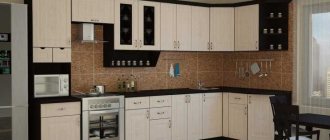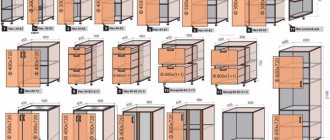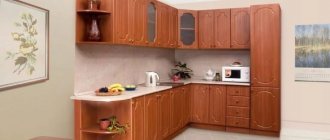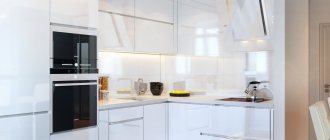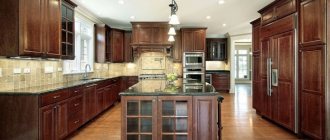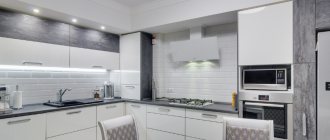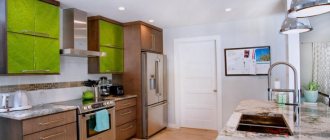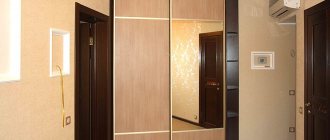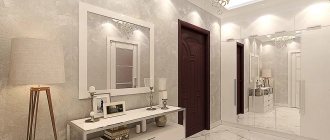Repairs in the kitchen are often much more expensive than in the bedroom, living room or hallway. Therefore, after restoration, I want to preserve this room in its original form for as long as possible. To protect the furniture, a kitchen unit plinth was developed. What it is? — A special strip located at the bottom of the floor modules, which performs not only decorative, but also protective functions.
What is it and why is it needed?
When ordering a kitchen set, the question invariably arises: should the lower tier have legs or not? All manufacturers insist on using furniture legs. After all, with their help, two problems are solved at once:
- during installation, it is convenient to level the lower cabinets by adjusting the height of the legs;
- they protect furniture in the event of a “flood” (the lower shelves and fronts remain above the water level).
But it would seem that not everyone likes such a practical accessory.
Most often, the legs are made of plastic or metal, and this design does not suit every style of kitchen. In addition, round products (potatoes, onions, etc.) are constantly rolled into the gap between the kitchen unit and the floor and excess dust and dirt gets clogged. Few people want to spend extra effort and time on cleaning.
The lower plinth for the kitchen set solves these problems. It reliably hides misplaced legs, and the presence of a special silicone seal protects the space under the lower cabinets from moisture and dirt.
Kitchen plinths: how to close the space under the box in kitchen furniture
The basis of the kitchen set is the lower tier boxes. Sometimes they are mounted on decorative supports, but more often inexpensive plastic legs are used for this. At the same time, there is always a space between the floor and the kitchen box, into which dirt and dust get over time. And simple black legs do not look aesthetically pleasing. A kitchen plinth helps protect this hard-to-reach space under furniture from dirt.
The plinth is a panel, usually plastic (although there are other options, such as an aluminum plinth or a chipboard plinth). The height of the plinth is usually 100, 120 or 150 mm, which corresponds to the most common options for the gap between the floor and the bottom box. The plinth is mounted on the legs using special clips. This approach makes it easy to remove and reattach the base to the legs. Not only the special shape allows you to secure the base tightly, but also the presence of a sealant, which is applied using the co-extrusion method, i.e. without glue. The color range of plinths is very diverse - these are various tree-like colors: oak, walnut, beech, ash, birch. For plain kitchens and kitchens in high-tech style, plinths are produced in the colors white, gray, bronze, vanilla and others. Metallized colors have also become widespread - matte aluminum and glossy aluminum.
#TOVAR_105085#
In addition to the base itself, hardware manufacturers produce a wide range of components. First of all, these are a variety of connecting corners, which are used in cases where the kitchen deviates from a simple linear shape. There are external and internal corners, with an angle of 90 and 135 degrees, as well as straight connectors of 180 degrees. Such connectors are used on long straight sections, when it is necessary to join several sections of the base. The multi-angle is very interesting - there is a flexible element in its center, which allows you to obtain angles of 90-135-180 degrees for the internal and external corners. All these components are available in heights of 100-120-150 mm and colors corresponding to the base. For boxes of round shapes, you can use radius elements: external, internal or universal. If it is necessary to ensure air flow into the space between the floor and the box, special ventilation grilles are cut into the base.
The process of installing the base looks like this: the clips are inserted into special grooves on the back wall of the base. Moreover, the clips in the groove can be moved freely, adjusting them to the location of the leg. Further, if necessary, individual sections of the base are connected through corner or straight connectors. The entire structure is then snapped onto the legs and finished off with end caps.
If the kitchen set uses a base made of chipboard, then you should choose a special plastic seal. This seal is resistant to moisture and reliably protects the space behind the plinth from dust and dirt. The seal is transparent, which allows it to be used with any chipboard color. It is important to keep in mind that the seal is mounted on a base made of 16 mm thick chipboard.
Don’t forget about the drawers under the plinth, which can be installed in the free space under the bottom box. At the same time, we get additional storage space. You can use a plastic plinth as a drawer front.
See also: Plinth for the kitchen 100 mm Plinth for the kitchen plastic Plinth for the kitchen 150 mm Plinth for the kitchen 120 mm Aluminum plinth for the kitchen
For or against?
There are no significant pros and cons to the kitchen plinth. Personal taste preferences rather play a role here. Some prefer the shiny chrome of metal legs, while others prefer the monolithic plane of the facade.
Most often, the advantages of the base include its aesthetic appearance. The decorative “skirt” makes it convenient to hide hoses and wires leading to the sink and kitchen appliances.
But you should realize that by hiding communications in this way, you can create a lot of problems for yourself. So, the breakthrough of a hidden hose will become known only when the size of the puddle is quite large (and, perhaps, the neighbors below will report the “flood”). After all, the sealing rubber will hold water under the kitchen unit for some time.
What materials are they made from?
Decorative overlays that hide the legs are made from different materials. Each of them has its own set of advantages and disadvantages. The most popular materials include:
- plastic (PVC). The most budget option. Despite the relatively low cost, a plastic strip is one of the best options. The material is resistant to moisture, quite flexible (easy to install and replace), and there is a fairly large selection of colors. A significant drawback is that the plastic does not always match the texture of the headset. For example, when combined with a natural array, it will look ridiculous;
- aluminum. The solution is very expensive, but these costs are justified. Aluminum is inert to moisture, environmentally friendly, durable and reliable. At the same time, such a “frame” looks stylish and expensive;
- Chipboard and MDF . These materials are selected only “as a set” for the headset. That is, when the set itself is made of MDF or chipboard. The protective functions of such a decorative strip are not very high; with prolonged contact with water, the material quickly swells and loses its original appearance. In some cases, the MDF panel is additionally protected with a special profile (a kind of plastic cover that fits onto the bottom of the plank);
- array. Due to the high cost, this base option is used extremely rarely. In most cases, decorative strips made of solid wood are made only to order for a specific set.
The beauty of the security strip is that it is fairly easy to install and remove. If the chosen option does not live up to expectations during operation, you can replace the base with your own hands with another one (by color or material).
Types and forms
Plinth strips cannot boast of a wide variety of designs. The entire range can be divided into straight and radius (for sets with curved facades).
It should be noted that kitchens with complex shapes may require custom-made plinths. In this case, there are many more possible design options.
Corrugated profiles (most often aluminum) are produced in limited quantities.
It looks original, but requires increased attention, since more dirt and dust gets clogged into the relief of the design. Typically, this type is chosen only when it fits perfectly with other interior elements, for example, chrome legs of a table or chairs.
Colors
The color palette of the plinths differs depending on the material from which it is made.
Aluminum decorative strips most often remain in a natural metallic color, and are divided only into mirror and matte. It is possible to apply an individual pattern on them in the form of engraving, but this type of finishing is not particularly widespread.
Plinths made of MDF and laminated chipboard are usually colored “wood-like”, “stone-like”, or in plain matte or glossy colors. The palette of this type of plugs is quite wide. It allows you to choose the right option for almost any kitchen design.
Protective strips made of natural solid wood are also left in their natural color, or they are opened with tinting varnish to match the headset.
Plastic bases have the widest range of possible shades. You can choose either monochromatic solutions or an option with a pattern (most often imitating the pattern of natural wood or stone). Delicate pastel colors or bright and aggressive - the choice is huge.
It is not always possible to select a decorative plug to match the kitchen set. A solution with a contrasting base is common. In this case, the protective profile matches the color of kitchen appliances or other interior elements. This solution looks stylish and emphasizes the originality of the design.
You should not choose a “custom-made” base from a catalog or based on the palette of samples provided. Colors in the photo and in reality may vary greatly. Moreover, the shade may vary from batch to batch (especially if we are talking about a natural array).
When arranging “to order” delivery, you may find yourself in a situation where the decorative strip is significantly different in tone from the facades. The best option: take the protective profile complete with the headset. If this is not possible, you should select a base only from stock.
When choosing a color scheme, you need to take into account the features of care. So the mirror base will have to be regularly rubbed with glass detergents. Doing this while lying on the floor is not very comfortable.
Glossy bases in bright colors will also require more careful care than matte ones. They show all the stains that most often remain after contact with a mop when wet cleaning the floor.
Types of base depending on material
Such parts are made from various materials. The most used are plastic strips (PVC), MDF, chipboard and aluminum profile. Depending on the material, the planks have different properties.
MDF plinth
Perfectly suitable for furniture with facades made of the same material, especially since choosing a strip of the desired color for them is not difficult. MDF is quite resistant to frequent washing, but you should still avoid excessive and constant wetting of the surface. Available in any height: 150 and 100 mm.
Articles on the topic (click to view)
- Metal kitchen rack for appliances
- Instructions for the electric stove "classic plus"
- How to choose an electric stove with 4 burners and an oven for the kitchen
- Sofa in the bay window for the kitchen
- Lighters for gas stoves
- Small enamel kitchen sink
- Electric Turk with automatic shut-off when boiling
Chipboard is an economical option
This material has a number of disadvantages that lead to its rapid wear and loss of external attractive qualities. Chipboard easily absorbs water and odors, quickly darkening with frequent cleaning.
As a result, the geometry of the surface is disrupted, and the strip requires replacement, since even the seal does not help, although its initial height is standardly 150 or 100 mm.
Aluminum profile
One of the best options for installing a protective strip between the floor and the bottom of furniture. This is a durable, lightweight option with a height of 150 or 100 mm.
The aluminum base is environmentally friendly, absolutely resistant to moisture and excess water, even in puddles that may form during the cleaning process. This profile is very easily attached to the legs of the headset, for which standard components are used.
Plastic base
Another option, which in its properties is superior to wood solutions for use on the kitchen floor. PVC is affordable and easy to install: installing such a bar is not difficult without special knowledge and skills. As a rule, its standard height is 150 or 100 mm.
This is the most convenient base for completing sets with curved facades, since the material bends easily without the risk of breaking. The color range allows you to choose a plastic strip to match any shade of furniture. It is the plastic profile that can be transparent, which will make the kitchen set more airy.
Expert opinion
Mikhailova Maria Vasilievna
Furniture store manager. Knows everything about comfort and interior design
The mirrored PVC base also looks interesting, making the room visually more spacious, although it is important to keep it absolutely clean.
An aluminum profile can also be like this, but it is more expensive, because it is superior to plastic in terms of wear resistance and strength. But it’s easier to select a variety of components for a PVC plug.
Dimensions: height, length, depth
To order, you can make a plinth of almost any length and height. But they do this extremely rarely. Most manufacturers of protective strips produce their products in three heights: 100, 120 and 150 mm.
These sizes were chosen for a reason. This height is ideal for the length of standard legs for kitchen furniture. Therefore, individual production of a base may only be required when working with an exclusive set of non-standard sizes.
Some manufacturers produce only the maximum width option, but with the ability to trim to 120 and 100 mm.
As for the length of the strip, it is also tied to certain standards. Depending on the manufacturer’s brand, it can be 3 or 4 m. Subsequently, such a blank is cut to the specific size of the headset.
The thickness of the base depends on two factors: the material and the manufacturer.
MDF and chipboard planks are usually produced from a standard 16 mm thick sheet. All accessories for them are produced in accordance with this standard.
The base is made of plastic and aluminum and is slightly narrower. Its thickness varies in the range of 10–14 mm. To reduce weight, planks made of these materials are produced hollow. There are special stiffening ribs inside, which make the structure quite strong and reliable.
Little secret
See also
Pantograph for a sliding wardrobe: luxury or convenience when you can’t do without it
A little final advice. Suitable for those who still chose MDF or laminated chipboard.
When making a base from these materials, it is recommended to make the height literally 3 mm less than the standard. That is, instead of 150 mm, cut 147 mm. Why is this necessary? It's simple. When installing from the end side, screw in the self-tapping screws. The step between them will be about 60-80 mm. In this case, the cap should remain 2-3 mm.
This allows you to place the base on the floor, but not directly touch the surface due to the gap of a few millimeters from the screw heads. The latter will act as supports, mini-legs. And if water starts to flow under the kitchen furniture, it will not touch the base. Thus, this allows you to avoid swelling of materials that are not particularly friendly with moisture.
Accessories
When installing a plinth made of MDF or chipboard, additional installation of PVC protection may be required. There are usually no problems with this.
The plinth protection is produced in standard sizes (for MDF sheet thickness 16 mm), and the strip is simply inserted into a plastic case (like a mobile phone) without additional fastening. The connection is tight and reliable, with virtually no gaps.
The thickness of the silicone protection is small, so its installation has virtually no effect on the overall height of the base. But the plastic “skirt” reliably protects the chipboard base from moisture and swelling.
In addition, there are models with a seal; they make the fit of the plank to the floor tighter, completely eliminating the possibility of moisture getting under the kitchen set.
The plastic cover does not spoil the appearance of the decorative strip, since it is completely transparent and makes itself felt only by the slight shine of the lower part of the base.
There are also a number of plugs and connecting strips. With their help, you can refine the ends of the plinth, or connect several parts of the decorative strip into a single structure. Depending on the configuration of the kitchen modules, the individual parts of the plinth can be connected at different angles, exactly repeating the shape of the set.
The following connectors are available as standard:
- 90 o - for assembling L-shaped and U-shaped kitchens;
- 135o - designed to form trapezoidal corners (near the sink);
- 180° - used when installing long straight headsets.
It is best to purchase such accessories immediately, complete with a plinth. At the same time, you need to make sure that it is from the same manufacturer and does not differ in texture and shade,
Also, when installing the base, you cannot do without special plastic clips. With their help, the strip is fixed on the legs of the kitchen set. Fasteners can be included with furniture legs, but are often purchased separately. The number, shape and size of clips are selected based on the material and dimensions of the base.
How to choose?
Each type of decorative strip has its own list of advantages and disadvantages. The best option should be selected taking into account the individual characteristics of the kitchen.
When choosing, you need to consider the following points:
- ceiling height. In a low Khrushchev building, a wide base will look disproportionate, disrupting the harmony of the interior. At the same time, a narrow base in a large kitchen will get lost and disrupt the holistic perception of the tall set;
- presence of built-in equipment. A plastic plinth is sold immediately with built-in ventilation, while a grille will have to be built into a plank made of MDF or chipboard. For an aluminum base, the ventilation grille will also have to be purchased and mounted separately;
- the material from which the kitchen set is made. A plastic plinth will visually reduce the cost of expensive exclusive furniture made from natural solid wood, etc.;
- kitchen style. Incorrectly selected details can turn the kitchen interior into a parody of a specific style. So, plastic will be inappropriate when embodying a retro style. Classic or loft also involve the use of only natural materials, but for high-tech, the dull chrome of aluminum or the glossy shine of bright plastic are perfect;
- required functionality. If the base is installed only for decoration, then the material will not have much significance (the main thing is that the chosen option is visually pleasing). When installing additional ventilation, lighting or drawers into the strip, you need to take into account the required level of strength (fire resistance, etc.) of the material;
- possibility of a flood. If the likelihood of flooding is high (there is a regularly leaking roof above or unfavorable neighbors live), it is better to choose materials inert to moisture (plastic, aluminum) for the base.
It is also worth considering personal preferences. If your “soul doesn’t fall in love” with a certain material or color, it’s better to choose another option rather than rely on “if you endure it, you’ll fall in love with it.”
Plastic plinth for the kitchen - the final touch in the design
In an attempt to create the perfect kitchen, many try to pay attention to all aspects, even those invisible at first glance. One of these optional, but “final” nuances of decorating furniture is the plinth, which is also often called the drawer or sidewall, but we will call it the generally accepted one.
Stylish metal base
What is the role of this element? Firstly, it allows you to hide from prying eyes what is under the legs of the kitchen furniture.
Secondly, you won’t have to sweep away dust, dirt and crumbs that have accumulated during the use of the kitchen from the farthest and “blind” corners.
Clean and tidy, everything is closed
Thirdly, the furniture is significantly transformed, and the overall design of the kitchen becomes complete. The base comes in three types depending on the material from which it is made:
Let's take a closer look at each type.
How to install?
Installation of the plinth begins with the correct installation of the headset legs. There are three main installation requirements :
- All legs of the headset must be installed on the same straight line (horizontal plane). This point is especially important when the wall near which the modules are mounted has an irregular shape (protrusions or niches). A difference in distance of 1–2 cm will cause the base to “wave” after installation, which will ruin the appearance of the kitchen set. When installing a rigid trim strip, the kitchen support clip may not snap into the correct position at all;
- During installation, the legs need to be pushed slightly under the headset. The level to which they should be “recessed” is selected individually. After installing the decorative strip, it should not protrude, interfering with the approach to the kitchen set. In addition, if the legs are not “recessed” enough, the base will interfere with opening the dishwasher door. In some cases, if the front of the dishwasher rests on the base, the strip is cut. But not everyone likes the gap that forms in this case;
- It is advisable to choose standard plastic supports for the headset. They are sold immediately complete with a clip-holder for the base, which simplifies the installation process. You can also install the base on decorative metal legs, but this will be much more difficult to do. Since they often have an original shape and size, complicating the process of selecting a mounting clip.
After installing the legs, the process of installing the plinth begins. To do this, the second part of the clip is fixed to it. You can screw it on with ordinary self-tapping screws, the main thing is to choose the correct length (so as not to damage the front part of the bar) and monitor the size and shape of the cap (it should not interfere with the clip). When installing it yourself, you need to make sure that both parts of the clip are at the same level.
There is no need to attach the base to all the legs of the headset. Usually only the edges are fixed. For decorative strips longer than 1.5 m, an additional attachment point is added in the center.
Furniture assembly. . Mounting the base. Furniture for kitchen.
When installing a plinth in a kitchen with curved facades, it is not always possible to select the desired radius of curvature of the decorative strip. There are two solutions to this problem:
- make small cuts along the stiffeners. The method is effective, but its implementation can damage the base. Also, the disadvantages of the method include the fragility of the final structure. Due to the cuts, such a structure turns out to be quite fragile and can burst during subsequent dismantling;
- heat the profile using a hairdryer or heater. This option is only suitable for working with a plastic base. When heated, the workpiece becomes soft and easily takes the desired shape. The main thing in the process is to ensure that the heating is uniform and at the same time not to allow overheating, otherwise the plastic may “float”. The process technology is shown in the video:
Bend a plastic plinth for the kitchen
If it is not possible to do without a slot for the dishwasher, then a cut is made in the right place. If done correctly, you can only notice it by dropping to the floor and looking under the façade.
Drinking under the dishwasher should not spoil the appearance of the base. If the cut is noticeable from any position, the base is installed incorrectly (it is not recessed enough under the lower modules). The gap should not be visible from human height.
It is quite possible to install or remove the base without the help of professionals. Usually it is dismantled for general cleaning or routine repairs. Products made from chipboard or MDF may need to be dried.
Difficulties can arise only with a swollen profile made of wood materials. In this case, the bar must be replaced (in most cases).
Installing a kitchen plinth
The kitchen plinth is mounted on legs that have a set of special fasteners.
Fig.3.
The plinth strip is secured to the legs with special fasteners that come complete with the legs. The installation of the plinth strip is highly dependent on the installation of the legs. If installed incorrectly, the plinth strip may protrude beyond the façade of the kitchen, which will ruin its appearance.
Therefore, you should begin installing the plinth with the correct positioning of the legs when assembling the kitchen. Here you should pay attention to two points: the installation of the front row of legs and side legs, of course, if the base will be attached to them.
Fig.4.
The fastening of plastic and laminated chipboard plinths is different. Various connecting elements are used to install the base. So the laminated chipboard plinth is fastened with self-tapping screws, and for the plastic plinth, fastening in a special groove is used.
The front row of legs should be installed in such a way that there is a distance of about 7 cm from the plane of the installed base and the end of the cabinets of the bottom row. In other words, the surface of the base should be recessed under the cabinets. This is necessary to create room for your feet when you stand close to the countertop, for example, when washing dishes. If you do not make the indicated displacement of the base, then it will be almost impossible to get close to the tabletop.
Fig.5.
The front row of legs should be offset relative to the facade by 7-10 cm. If the plinth is to be installed from the side of the kitchen, then the legs should be offset by at least 20 mm. This way the base will not protrude beyond the surface of the cabinet walls.
This circumstance does not apply to the base located on the side of the cabinets, but here another problem arises - an aesthetic one. It is almost impossible to make a plinth flush with the cabinet, without differences and gaps. Therefore, here too it is advisable to make a small indentation from the edge of the cabinet. It is necessary to preserve the aesthetics of the kitchen set.
Fig.6.
In this example, the front legs are offset by 10 cm, and the side legs by 3 cm.
Ventilation grill
The ventilation grille in the base is not a mandatory element; it is installed as needed. Most often, the grille is installed in kitchens with high humidity (first floors, private houses), or complete with built-in appliances.
An oven or refrigerator built into a kitchen unit needs good cooling. Ventilation grilles in the base provide the equipment with the necessary air flow, protecting it from overheating.
The grille can be not only a functional element, but also a decorative one. With the right selection of design, this part of the fittings can become a decoration of the kitchen set.
Some plinths are sold with a ventilation grill already installed (most often plastic), for the rest you have to purchase it separately.
It should be noted that the market for finishing materials does not have a wide range of ventilation grilles. Most hardware stores can only offer white and chrome models.
If you try, you can find grilles that are black, gray or beige. If you need a different tone, then the workpiece will have to be painted in the required tone yourself. As for the shape of the product, in nine cases out of ten it will be rectangular.
Usually the grille is cut into the base before it is installed. The place for it is selected individually (away from joints and fasteners, but, at the same time, closer to the built-in equipment).
Is there a need for a drink in the base under the dishwasher?
There is no clear answer to this question. It all depends on the model and installation location of the dishwasher, as well as on the configuration of the kitchen unit.
In most cases, drinking is not technologically necessary. When installing, it is enough to push the legs and plinth a little deeper under the kitchen cabinet. But, again, a matter of taste plays a role here. Some people like “floating” furniture, while others find it easier to put up with drinking.
If the kitchen furniture was bought ready-made and not made to order, then there is a possibility that the legs cannot be moved to another place. In this case, the base is installed as the design allows. There is a possibility that in such a situation it will not be possible to install a dishwasher without a cut in the base.
Introduction
In order not to reinvent the wheel every time when designing kitchen furniture, all furniture today is created in accordance with established standards.
These standards were previously invented by trial and error and depended on the comfortable use of furniture by the consumer, as well as on the dimensions of CNC processing machines.
No matter how stylish your kitchen is, when designing it, certain standard dimensions must always be maintained, on which the comfortable operation of all work areas in the kitchen will depend.
Do you need drawers in the plinth?
The answer to this question depends on the overall size of the kitchen and the organization of free space. If the area of the room allows you to sacrifice this space, it is better to do so.
Boxes in the base are not a very good solution. The main disadvantages of this solution include:
- inconvenience of use. Young and healthy people can easily bend down to the floor. For older people or those with health problems (back problems, blood pressure, excess weight), this configuration can cause a lot of inconvenience;
- storage features. The height of such a box usually does not exceed 5–8 cm, and the likelihood of a flood should be taken into account. That is, all contents can be damaged at any time. As a result, only something flat, inert to moisture and not very in demand can be stored there;
- rise in price. Installation of boxes assumes that the base will be securely fixed and made of durable materials. A decorative strip made of plastic will not work in this case. Taking into account the cost of hidden fittings, materials, work, etc., the cost of such a plinth will be two to three times more expensive than a similar one, but without drawers.
The drawers in the lower bar are favored by their original appearance. It is also worth noting that such a place is well suited for organizing a hiding place. True, it will be convenient to store only jewelry in it. Money or documents may be damaged in the event of a flood.
If you need to get a full-fledged, functional storage space, the base for the drawers is made wide enough (20–40 cm). It is made individually, taking into account a small indentation from the floor. This option is quite practical, but expensive, and looks harmonious only in kitchens with high ceilings.
How to make a kitchen plinth with your own hands?
There should be an overhang of mm in front covering the facades. And most importantly, behind the box there should be another mm to the wall to compensate for the curvature of the adjacent corners. We will simply cut off the excess from the tabletop.
I hope it’s clear, but this is not our method. If you dare to order a tabletop, you can make it of any depth - the main thing is to reach the wall.
We will make the drawers on full extension ball guides. They come up to mm.
Just first you need to decide how much it is necessary. There are many manufacturing methods - you can choose an artificial stone, or, as in the photo, make it from 40x40mm timber. Glue the beams themselves and place them on dowels, or glue them together from plywood of the required thickness and lay tiles on top. There are many options. The main thing is not to overdo it with thickness. One addition - if you have a separate mortise hob, then there is a reason to make more space from the back edge of the hob to the wall apron, approximately mm. Sometimes there are slabs that protrude slightly forward.
A correctly assembled plinth system makes the false panel itself easily removable.
Backlight
It is impossible to organize full kitchen lighting using plinth lighting; this element can only perform a decorative function.
There are two ways to organize lighting:
- lighting fixtures cut into the decorative strip. They can be installed along the entire length of the base, or highlight a certain part of the headset;
- The LED strip is attached along the upper edge of the base, or along it along the bottom of the modules. This option is used to create the effect of “floating” furniture. For proper installation, the bar must be pushed well under the lower modules (only the light from the tape should be visible, and not the tape itself).
The second installation option is preferable, as it is more secure. Do not forget about the possibility of a flood and the risk of a short circuit.
Is it necessary for a kitchen to have legs or a plinth, maybe you can do without them?
The difference between the base and the legs is clear. The advantages of decorative strips include:
- additional protection from moisture and dust;
- tidier appearance;
- original design;
- ability to hide wires and pipes.
Open legs also have a number of advantages:
- additional free space;
- a more “airy” type of headset;
- additional ventilation;
- free access to communications.
The number of fans for the first and second solutions is approximately the same. But there is a certain percentage of people who are categorically against legs on a kitchen set. Regardless of whether they are hidden behind a decorative strip or on display.
In this case there are three solutions:
- make the lower cabinets hanging , attaching them only to the wall, without lower support. The idea is modern, original and convenient (it’s easy to clean under the cabinets, it’s convenient to store large items under them, for example, skis). But this option is only suitable if you have a good-quality monolithic wall. It is also worth considering the strength of the material from which the cabinets are made and the weight of the contents of hanging shelves and drawers;
- make drawers from the floor itself . This option is not distributed. Such a design will have to be made to order (and you will still have to look for a craftsman). There are four reasons for the unpopularity of this solution: the lower drawers and their contents are constantly under threat of flooding;
- it is difficult to level the tabletop during installation;
- the set will highlight the slightest unevenness of the floor. Moreover, if the difference in the floor covering is 1–2 cm or more, the lower drawers may have problems opening;
- there is a more budget-friendly and practical analogue (boxes in the plinth);
- make the base a stationary part of the structure. In this case, the lower cabinets are mounted not on legs, but on a permanent box made of chipboard or MDF. In order for this design to last longer, it is installed in a special plastic base. This solution cannot be called a complete rejection of legs, but this option can safely be considered the most practical and convenient of those proposed.
Refusal of legs entails many problems during the operation of the headset. When choosing this option, you need to carefully consider it first, studying all the pros and cons.
Kitchen plinth – a practical decoration with great possibilities
Olesia, are you interested in options with built-in equipment? Previously, I was also categorically not happy with my kitchen, until they changed it to an option with built-in appliances. Irina Shvetsova, September 10 With your permission, a little of my text on this topic.. We are all specialists here and I will cut out the artistic part, leaving only the idea itself: Anatomy of a comfortable kitchen. I’m telling you a terrible secret: all people have different heights and dimensions! And we need to work in the kitchen with a straight back, so we get tired less and the process of preparing masterpieces will bring joy, this is the main condition and we will move away from it.
Everything we do in the kitchen is with a straight back. Washing dishes: The standard height of the sink countertop is 83 cm. Some will wash dishes, bending over and resting their foreheads on the cabinet, this is how my brother washes when he grows, while others can, of course, put up a bench. The correct sink height is calculated as follows: the height of your elbow from the floor minus the height of your fist. Example: I have cm from the floor to the elbow, my fist is 8 cm, which means it will be 98 cm. A dishwasher does not solve the problem, but makes life a little easier.
Like that. Desktop Here everything is much more complicated; when preparing something tasty, there are two types of cutting of the product. Silovaya, cabbage, frozen or slightly thawed meat and fish products, etc.
In the case of force, we cut with great effort and our goal is to cut or chop smaller. Accurate - requires us to make thin and neat slices.
Having looked at the structure of the human body, we can draw a conclusion: it is easier to make significant efforts in a standing position somewhere at waist level, we involuntarily help with the body, our back is straight, our main condition And it will be more convenient to thinly cut the doctor's sausage into Borodino bread higher up, somewhere at sink height level. Maybe a little lower.
Cooking surface Everything is simple here - take your tallest pan and find the height where you can look into it without standing on your tiptoes, just “squinting” your eyes a little. Leaning your head over the pan is very harmful due to the high temperature of the steam.
You can gain height using books by placing them under the bottom of the pan. Oven It is convenient to watch the process through the window of the cabinet door. Here, perhaps, we can voice the numbers - cm from the floor to the top of the oven will be good. I bought exactly this one for myself. It is very convenient to remove the carcass from the grill and turn it over at chest height.
Under the cabinet there is space for drawers for dishes. The entire box for the oven with the countertop turned out to be see Oven and base Oven and base 5.
The base is a useful thing.. This is the place where our foot should go so that we can come close to the tabletop. Sometimes my colleagues save a little on this.
I make it 10 cm deep and 12 cm high. But there is an empty space under the floor of the box, you say! Let's make a fully roll-out box with a height of 9 cm. It will be possible to store the bottom. We have considered it completely. Standard tabletop size mm.
This is explained by the fact that the depth of the built-in equipment is from to mm.
